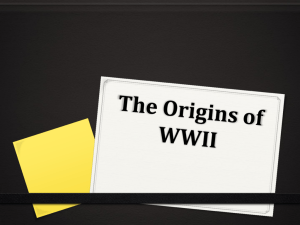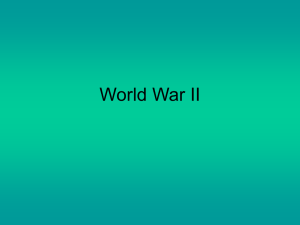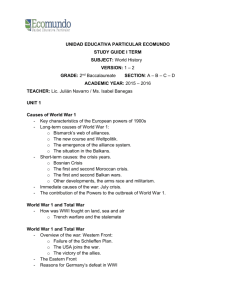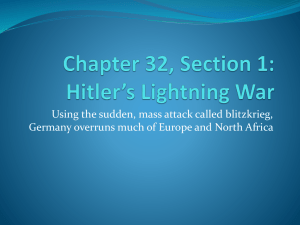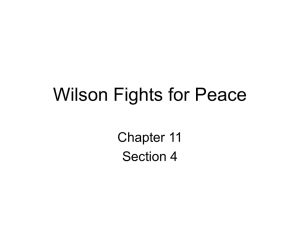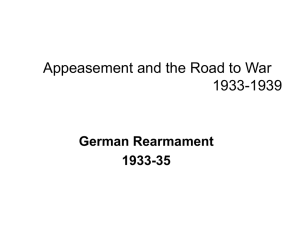WWII Chart Reading
advertisement
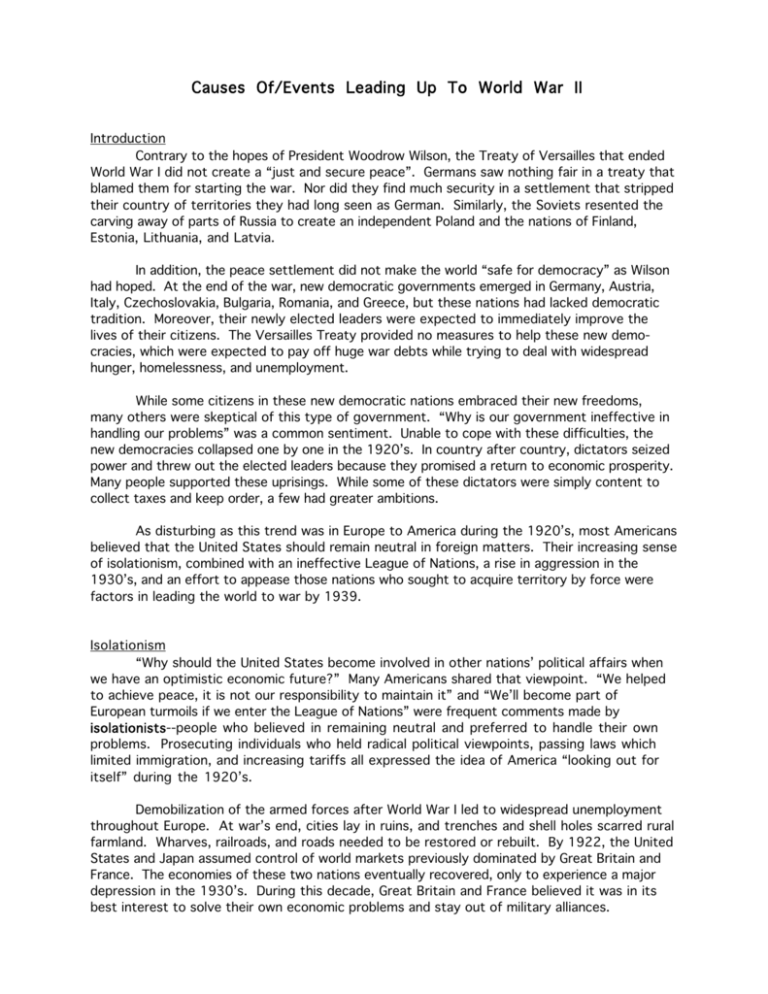
Causes Of/Events Leading Up To World War II Introduction Contrary to the hopes of President Woodrow Wilson, the Treaty of Versailles that ended World War I did not create a “just and secure peace”. Germans saw nothing fair in a treaty that blamed them for starting the war. Nor did they find much security in a settlement that stripped their country of territories they had long seen as German. Similarly, the Soviets resented the carving away of parts of Russia to create an independent Poland and the nations of Finland, Estonia, Lithuania, and Latvia. In addition, the peace settlement did not make the world “safe for democracy” as Wilson had hoped. At the end of the war, new democratic governments emerged in Germany, Austria, Italy, Czechoslovakia, Bulgaria, Romania, and Greece, but these nations had lacked democratic tradition. Moreover, their newly elected leaders were expected to immediately improve the lives of their citizens. The Versailles Treaty provided no measures to help these new democracies, which were expected to pay off huge war debts while trying to deal with widespread hunger, homelessness, and unemployment. While some citizens in these new democratic nations embraced their new freedoms, many others were skeptical of this type of government. “Why is our government ineffective in handling our problems” was a common sentiment. Unable to cope with these difficulties, the new democracies collapsed one by one in the 1920’s. In country after country, dictators seized power and threw out the elected leaders because they promised a return to economic prosperity. Many people supported these uprisings. While some of these dictators were simply content to collect taxes and keep order, a few had greater ambitions. As disturbing as this trend was in Europe to America during the 1920’s, most Americans believed that the United States should remain neutral in foreign matters. Their increasing sense of isolationism, combined with an ineffective League of Nations, a rise in aggression in the 1930’s, and an effort to appease those nations who sought to acquire territory by force were factors in leading the world to war by 1939. Isolationism “Why should the United States become involved in other nations’ political affairs when we have an optimistic economic future?” Many Americans shared that viewpoint. “We helped to achieve peace, it is not our responsibility to maintain it” and “We’ll become part of European turmoils if we enter the League of Nations” were frequent comments made by isolationists--people who believed in remaining neutral and preferred to handle their own problems. Prosecuting individuals who held radical political viewpoints, passing laws which limited immigration, and increasing tariffs all expressed the idea of America “looking out for itself” during the 1920’s. Demobilization of the armed forces after World War I led to widespread unemployment throughout Europe. At war’s end, cities lay in ruins, and trenches and shell holes scarred rural farmland. Wharves, railroads, and roads needed to be restored or rebuilt. By 1922, the United States and Japan assumed control of world markets previously dominated by Great Britain and France. The economies of these two nations eventually recovered, only to experience a major depression in the 1930’s. During this decade, Great Britain and France believed it was in its best interest to solve their own economic problems and stay out of military alliances. An Ineffective League Of Nations During the 1920’s, leaders in Western Europe were hopeful that a new era in international relations would dawn. They looked to the League of Nations to keep the peace. The League was based on the concept of collective security--that is, an organized community acting together to preserve peace and solve international disputes. Although the League maintained no military, it utilized four methods to punish member nations: the breaking of diplomatic ties, imposing economic sanctions, ordering a naval blockade, and commanding a military invasion. In the 1920’s, the League was successful in using the first three strategies to settle a number of minor disputes, and its efforts culminated in the 1929 Kellog-Briand Pact. Sixty-two nations, including the United States, signed the pact that “renounced war as an instrument of national policy”, although there was no means to strictly enforce this agreement. Lurking in the shadows, however, was the increasing military strength of Italy, Germany, and Japan. Members of the League were unwilling to directly confront these nations, nor were they motivated to fully investigate their intentions. Moreover, Great Britain and France did not consider the rise of these nations as a threat to their national security, since neither country’s policies directly affected them. When these countries initiated aggressive campaigns to claim territory, the League simply used its first tactic to punish them. Its member nations were unwilling to take drastic actions to stop aggressive acts. By 1938, Germany, Italy, and Japan simply left when threatened by action from the League of Nations. Aggression Beginning in the 1920’s, the military gained increasing power in the Japanese government. This nation had slowly developed into an industrial power and engaged in imperialism. By 1932, Japan had conquered Korea and assumed control of Manchuria. China, which claimed ownership of Manchuria, appealed to the League of Nations for help. When the League ruled that Manchuria was part of China, Japan withdrew from the League. In response, Henry Stimson, the Secretary of State, issued a statement that the United States did not recognized forced territorial acquisitions. Meanwhile, the Italian Fascist Party, led by Benito Mussolini, focused its policy on improving Italy’s economy by increasing taxes, reducing government spending, and suppressing labor organizations. Ethiopia, one of the few independent nations remaining in Africa, became the object of Mussolini’s ambitions. In December 1934 Italy invaded Ethiopia. In response, Congress passed the First Neutrality Act, which forbade American companies from selling military equipment to any nation at war, and the Second Neutrality Act, which forbade American banks from lending money to any nation at war. When Japan invaded China in July 1937, FDR did not invoke these acts. Furthermore, responded in a speech in October that the United States and its allies have a moral obligation to quarantine, or stop, aggression worldwide. Many American citizens were outraged that American neutrality was being called into question. Germany, led by Adolf Hitler, initiated a massive defense project designed to rebuild its armed forces, pursue his goal of united Germans who lived in other nations, and expand its borders. In 1936, Hitler ordered the Rhineland, a region that bordered Germany and France, to be occupied and remilitarized in defiance of the Versailles Treaty. His generals warned him of Germany’s military unpreparedness in the event of a British and French invasion, but these two nations simply voiced their objections. By 1937, Germany’s military strength rivaled the British. In summer 1938, Germany annexed Austria. The League of Nations, led by Great Britain and France, warned Germany it did not have the right to invade a sovereign, or free, nation. In addition, Germany demanded the Sudetenland from Czechoslovakia, a region formed in 1919 as part of the Versailles Treaty. A significant number of Germans lived in this area. Diplomats from the Soviet Union offered to defend the Czechs with British and French assistance, but their offer was rejected by these two nations. Appeasement A conference was between Germany, Italy, Great Britain, and France was held in Munich on September 29, 1938. Great Britain and France wanted to avoid war because they were dealing with various social problems, their citizens demanded peace, and the leaders of these two nations believed Germany would not ask nor take more land. Great Britain and France accepted Hitler’s demand the Sudetenland be annexed to Germany and promised Czechoslovakia to aid it against future aggression. They appeased Hitler, or preserved peace by yielding to the demands of an aggressor. Upon his return to London, British Prime Minister Neville Chamberlain announced “I believe it is peace for our time” to a cheering crowd. Winston Churchill, a member of Parliament, led a small but vocal group who believed that Hitler’s goal was to conquer Europe. He feared that Germany would invade Czechoslovakia, which it did in March 1939. Chamberlain resigned, Great Britain and France did not come to the assistance of Czechoslovakia, and Churchill became the new prime minister. The Beginning Of World War II Great Britain and France prepared for possible war and declared their intention to protect Poland from German aggression, sensing it would be Hitler’s next move. In summer 1939, the Soviet Union, led by Josef Stalin, suggested an alliance with these two nations against Germany. Great Britain and France, refused, citing their objection to its communist form of government and his insistence that Poland, Finland, and the Baltic countries of Estonia, Latvia, and Lithuania become part of the Soviet Union in return for their help. During this time Stalin also met with Hitler. In August 1939 he and Hitler secretly signed the Nazi-Soviet Pact, in which both countries agreed not to attack one another and to divide Poland between them. Even though both leaders despised one another, it made perfect sense. Hitler wanted an assurance of Soviet neutrality to prevent a two-front war while he battled France and Great Britain. Stalin envisioned assuming more territory and preparing his nation for its eventual, inevitable military encounter with Germany, which invaded in 1941. The crisis that led to World War II involved Poland. Hitler insisted that Danzig be returned to Germany. This city, located near the Baltic Sea, was part of a narrow strip of territory called the Polish Corridor that cut through Germany. This area was controlled by the League of Nations to ensure Poland access to the Baltic Sea. On September 1, 1939, Germany annexed Danzig and launched a massive military strike on Poland. The world had never seen anything like it and learned a new word--blitzkrieg, or lightning war, which involved bombings on major cities followed by an assault by mechanized divisions. Great Britain and France kept its word to defend Poland and declared war on Germany. In response, Congress passed the Fourth Neutrality Act, which allowed American businesses to sell military equipment to warring nations only on a “cash and carry” basis.
